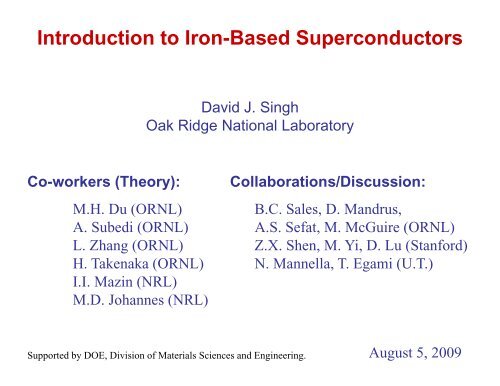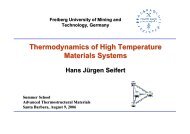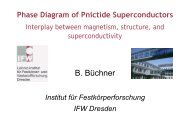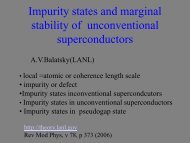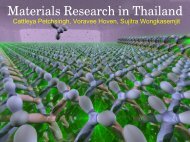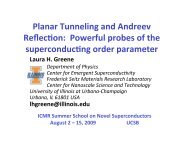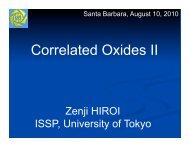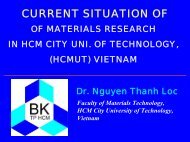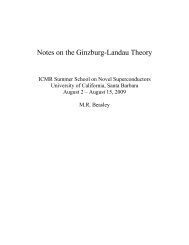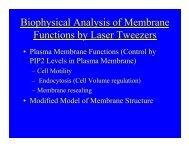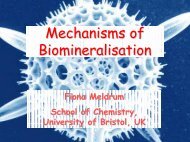Introduction to Iron-Based Superconductors
Introduction to Iron-Based Superconductors
Introduction to Iron-Based Superconductors
You also want an ePaper? Increase the reach of your titles
YUMPU automatically turns print PDFs into web optimized ePapers that Google loves.
<strong>Introduction</strong> <strong>to</strong> <strong>Iron</strong>-<strong>Based</strong> Superconduc<strong>to</strong>rs<br />
David J. Singh<br />
Oak Ridge National Labora<strong>to</strong>ry<br />
Co-workers (Theory):<br />
Collaborations/Discussion:<br />
M.H. Du (ORNL) B.C. Sales, D. Mandrus,<br />
A. Subedi (ORNL) A.S. Sefat, M. McGuire (ORNL)<br />
L. Zhang (ORNL) Z.X. Shen, M. Yi, D. Lu (Stanford)<br />
H. Takenaka (ORNL) N. Mannella, T. Egami (U.T.)<br />
I.I. Mazin (NRL)<br />
M.D. Johannes (NRL)<br />
Supported by DOE, Division of Materials Sciences and Engineering. August 5, 2009
<strong>Iron</strong><br />
The <strong>Iron</strong> Ring: Traditionally given <strong>to</strong><br />
Canadian engineering graduates and<br />
worn by professional engineers.
Materials<br />
LaFeAs(O,F)<br />
Basic Research Needs for Superconductivity (DOE, 2006)
A Brief <strong>Introduction</strong> <strong>to</strong> Cuprates<br />
Insula<strong>to</strong>r<br />
• Prominent Mott Insulating Phases<br />
(not described in band structure)<br />
• Structural complexity (perovskite)<br />
• Doping is essential<br />
• Copper is essential (e.g. Zn alloying<br />
destroys superconductivity)<br />
T<br />
AF Mott<br />
Insula<strong>to</strong>r<br />
Pseudo-gap<br />
Metal<br />
Metal<br />
Superconduc<strong>to</strong>r<br />
Doping Level
Discovery of Superconductivity in Fe-As<br />
Compounds<br />
Kamihara et al., JACS,<br />
2006<br />
LaFePO, T c ~ 4K<br />
Kamihara, Watanabe and<br />
Hosono, JACS, Feb. 2008<br />
LaFeAsO 1-x F x T c =26K
Kamihara et al.<br />
Phase Diagram of LaFeAs(O,F)<br />
The undoped compound is now<br />
known <strong>to</strong> be an antiferromagnetic<br />
metal.
Fe-based Superconducting Families<br />
ZrSiCuAs<br />
ThCr 2 Si 2<br />
LiMnAs<br />
PbO<br />
P4/nmm<br />
I4/mmm<br />
P4/nmm<br />
P4/nmm<br />
~55K ~40K ~20K ~40K<br />
Superconductivity is robust. Occurs across a broad range of<br />
compositions, including replacement of As, and doping on the Fe<br />
site.
Pressure Dependence in Fe 1+x Se<br />
S. Medvedev et al. (cond-mat, 2009).<br />
9 GPa
FeSe - The “Simplest” Fe-Superconduc<strong>to</strong>r<br />
• Simple tetragonal structure, four a<strong>to</strong>ms per unit cell (Hagg and<br />
Kindstrom, Z. Phys. Chem. (1933).<br />
• Actual material is Fe 1+x Se, with extra<br />
Fe in holes of Se lattice.<br />
• LiFeAs is similar, but extra sites are<br />
filled with Li.<br />
d Fe-Fe = 2.66 Å
A Word About Structure<br />
• Large size of As 3- ,Se 2- relative <strong>to</strong> Fe 2+ leads <strong>to</strong> tetrahedral structures<br />
with anion contact (edge shared tetrahedra). Tendency <strong>to</strong> high<br />
symmetry, small unit cells without structural dis<strong>to</strong>rtion.<br />
• Cuprates, etc. are based on corner shared units, with resulting tendency<br />
<strong>to</strong> complex structure dis<strong>to</strong>rtions. The interplay with properties greatly<br />
complicates the physics.<br />
Bi-2212 – Zandbergen et al.
A Word About Structure<br />
(Ca,Sr) 2 RuO 4 : Nakatsuji, et al.<br />
(Friedt et al., 2000)
Perovskite Tilt Modes<br />
• Corner sharing polyhedra with even numbered rings.
Phonons and Electron-Phonon Interaction<br />
• First principles calculations allow direct calculation of pairing<br />
interaction, and almost first principles calculation of T c .<br />
• Calculations show weak coupling, no superconductivity (λ ep ~0.2).<br />
Boeri, et al., PRL (2008); also Mazin, et al., PRL (2008).<br />
• Fe/As phonons are<br />
below 300 cm -1 .<br />
• Corresponding Ni<br />
compounds, LaNiPO,<br />
LaNiAsO, BaNi 2 As 2 ...<br />
are electron-phonon<br />
superconduc<strong>to</strong>rs!<br />
• Fe compounds are not<br />
electron-phonon<br />
superconduc<strong>to</strong>rs.
LDA Electronic Structure of FeSe<br />
• A rather ionic material – Fe 2+ and Se 2- with some hybridization, as in<br />
an oxide metallic sheets of Fe 2+ modified by interaction of anions.<br />
• Pauling electronegativities: Fe = 1.83; Se = 2.55; As = 2.18.<br />
Se p<br />
Fe d<br />
Fe 2+ d 6<br />
N(E F ) is at<br />
bot<strong>to</strong>m of<br />
pseudogap.
Arsenide Electronic Structure: LaFeAsO<br />
• LaFeAsO: Rather ionic electronic structure: O 2- , As 3- , La 3+<br />
• Bands near E F are derived from Fe with little As admixture<br />
O As Fe Metallic<br />
sheets of<br />
Fe 2+<br />
E F is at the<br />
bot<strong>to</strong>m edge<br />
of a<br />
pseudogap<br />
High N(E F )<br />
near<br />
magnetism<br />
D.J. Singh and M.H. Du, PRL 100, 237003 (2008)
Fermi Surface of<br />
LaFeAsO<br />
(not spin polarized)<br />
Low carrier density:<br />
n e =n h =0.13 / Fe<br />
Band anisotropy: / ~ 15 <br />
a modest value that is favorable for applications.
Normal Metallic State<br />
• Low carrier density semi-metal (dis-connected small Fermi surfaces).<br />
• Less anisotropic than cuprates, even YBa 2 Cu 3 O 7 .<br />
• High N(E F ).<br />
• Near itinerant magnetism in general.<br />
• Expect short coherence length relative <strong>to</strong> T c .<br />
• Expect high superfluid density.<br />
• Electron-Phonon interaction is weak (λ~0.2, T c =0)
Formation of Band Structure<br />
• Bands from -2 eV <strong>to</strong> +2 eV are derived from Fe 2+ d-states.<br />
•Fe 2+ has 6 d-electrons.<br />
Tetrahedral Crystal Field Scheme:<br />
3d 10e<br />
t 2g 6e<br />
e g 4e<br />
Does not correspond<br />
<strong>to</strong> the calculated<br />
electronic structure.<br />
Key is the short Fe-Fe bond length <br />
direct Fe-Fe interactions.
Coulomb Correlations<br />
• LDA and correlated approaches give<br />
different predictions.<br />
• So far Hubbard bands are not seen;<br />
strong Fe d character is seen at<br />
Fermi edge.<br />
• There is however a renormalization<br />
of ~2 in band width c.f. LDA.<br />
X-ray spectra,<br />
Kurmaev,<br />
et al.<br />
DMFT<br />
Fe (d)<br />
Haule and Kotliar
Metallic Character<br />
Pho<strong>to</strong>emission: LaFePO (D.H. Lu et al.)<br />
O p ,As p<br />
Fe d<br />
Very prominent<br />
Fermi edge (not<br />
like cuprates).<br />
Fe d bands are<br />
narrower (by ~2)<br />
compared <strong>to</strong> LDA.
LaFeAs(O,F) Lindhard Function<br />
• Neglecting Matrix Elements:<br />
Im χ 0 /ω Re χ 0<br />
Scattering, Transport<br />
Magnetism, Superconductivity<br />
Note the pronounced peak at the zone corner.<br />
I.I. Mazin, D.J. Singh, M.D. Johannes and M.H. Du, PRL 101, 057003 (2008)
Spin Fluctuations and Superconductivity<br />
One way <strong>to</strong> proceed (weak coupling):<br />
• Calculate matrix elements V k,k’ for a set of k,k’ on the FS.<br />
• Set-up gap equation -- diagonalize V.<br />
Berk-Schrieffer-Fay-Appel weak<br />
coupling theory, 1966-1980:<br />
+<br />
-<br />
Electron doped LaFeAsO<br />
I.I. Mazin, D.J. Singh, M.D. Johannes and M.H. Du, PRL 101, 057003 (2008)<br />
Singlet:<br />
V(q) = -<br />
I 2 (q)χ 0 (q)<br />
1 - I 2 (q)χ 02 (q)<br />
In a singlet channel there is a minus sign for<br />
spin fluctuations (repulsive), which then<br />
favors opposite order parameters on the<br />
electron and hole sheets s +/- state.<br />
Note prior work, Aronov & Sonin (1972);<br />
Kuroki and Arita (2001)<br />
Does not have an obvious strongly q-<br />
dependent interaction for nodes in a FS.
Spin Fluctuation Driven s +/-<br />
Properties<br />
• Two gap.<br />
• SDW and superconductivity are driven by the same<br />
interaction and compete for the same electrons.<br />
• Simplest form is nodeless, but this is not essential.<br />
• Robust against low q scattering (Co, Ni doping)<br />
• No corner junction shifts (s-wave symmetry)<br />
• Coherence fac<strong>to</strong>rs depend on q. Reduced Hebel-Slichter<br />
peak in NMR relaxation rate.<br />
• Resonance peak in neutron scattering.
Small Fermi Surfaces in General<br />
• Does superconductivity arise in general if one has small Fermi surfaces<br />
with nesting driven spin fluctuations? – Answer seems <strong>to</strong> be no.<br />
Γ<br />
+ -<br />
p-wave state (triplet): spin-fluctuation<br />
pairing interaction has + sign Pair<br />
breaking for the state shown.<br />
Γ<br />
+ +<br />
s-wave state (singlet): spin-fluctuation<br />
pairing interaction has – sign Pair<br />
breaking for the state shown.<br />
e.g. small pockets on Na x CoO 2 (Johannes et al., 2004).<br />
In such cases, look for chemistry with strong electron phonon and low<br />
S<strong>to</strong>ner parameter, <strong>to</strong> obtain Kohn anomaly and e-p superconductivity or<br />
maybe strange states, e.g. odd frequency.
T=7K<br />
T=50K<br />
Magnetic Resonance<br />
Sign changing gap with q corresponding <strong>to</strong> (π,π)
Fully Gapped: Andreev<br />
reflection, ARPES penetration<br />
depth (oxy-arsenides), tunneling.<br />
Gap Structure<br />
Power Law (e.g. Line Nodes):<br />
BCS<br />
Microwave penetration depth, PrFeAsO 1-x<br />
K. Hashimo<strong>to</strong>, et al., PRL (2009).<br />
NMR, LaFeAs(O,F)<br />
Y. Nakai, et al., JPSJ (2008).
Gap Structure<br />
If some compounds have a clean gap and others have nodes, does this<br />
mean that there are two competing (different) superconducting states,<br />
such as s+/- and something else?<br />
Δ 1<br />
s+/- Competing State<br />
?<br />
Δ 2
Gap Structure<br />
If some compounds have a clean gap and others have nodes, does this<br />
mean that there are two competing (different) superconducting states,<br />
such as s+/- and something else?<br />
Δ 1<br />
s+/- Competing State<br />
?<br />
Δ 2
Gap Structure<br />
If some compounds have a clean gap and others have nodes, does this<br />
mean that there are two competing (different) superconducting states,<br />
such as s+/- and something else?<br />
Δ 1<br />
s+/-<br />
Δ 2<br />
Why should this<br />
happen?
Fermi Surface Structure<br />
Fermi surface shaded by d xz/yz character<br />
FeSe<br />
LaFeAsO<br />
z 2<br />
xy<br />
A. Subedi<br />
Lobes of the electron sheets are not as nested<br />
as the inner parts due <strong>to</strong> matrix element
Neutron Scattering – Magnetism & Structure<br />
LaFeAsO:<br />
Ordered m(Fe) = 0.36 μ B<br />
(other compounds so far are between 0.3 and 1 μ B )<br />
C. de la Cruz et al., Nature 453, 899 (2008)
In-plane SDW structure<br />
+ - + -<br />
- + - +<br />
+ - + -<br />
1 D Chains of parallel<br />
spin Fe a<strong>to</strong>ms.<br />
-<br />
+<br />
-<br />
+
Nesting, Doping and the Lindhard Function<br />
holes<br />
electrons<br />
Re χ 0<br />
I -1<br />
T<br />
SDW<br />
SC<br />
SC<br />
q<br />
Doping Level<br />
Could we realize disorder induced superconductivity?
SrFe 2 As 2 (Sebastian et al.)<br />
Metallic SDW State<br />
Shubnikov – de Hass measured by tunnel<br />
diode method.<br />
SDW state has quantum oscillations reflecting<br />
a Fermi surface and is therefore a metal.
NMR: Connection of SDW and SC States<br />
1/T 1 T shows<br />
strong spin<br />
fluctuations<br />
(constant for<br />
ordinary F.L.)<br />
Ning, et al., JPSJ 78, 013711 (2009) – Ba(Fe,Co) 2 As 2.
Implications for Models<br />
• Models reduce the degrees of freedom in order <strong>to</strong><br />
extract and understand the important physics. They<br />
must retain fidelity <strong>to</strong> the important aspects of the<br />
physical system <strong>to</strong> be relevant.<br />
• The FeSC are NOT near Mott insula<strong>to</strong>rs in any<br />
normal sense – a Mott insulating state is not<br />
produced by doping, alloying, pressure, magnetic<br />
field or other small or even large experimentally<br />
realizable perturbations.<br />
• Models “near” a Mott insula<strong>to</strong>r (small parameter<br />
changes produce a Mott state) need improvement.
Resistivity in LaFeAsO<br />
McGuire et al. (cond-mat):<br />
Hall:<br />
Resistivity:<br />
Evidence of strong interplay of<br />
magnetic ordering and Fermi surface.<br />
Evidence of spin fluctuations.
Strong Spin Fluctuations in Normal State<br />
• Transport data.<br />
• Susceptibility - χ(T).<br />
• Spectroscopy.<br />
• Scattering.<br />
• Overly magnetic in LDA.<br />
• Precursor structural transition.<br />
FeO<br />
Fe<br />
CeFeAs(O,F)<br />
Fe 3s<br />
Bondino et al. (2008); c.f. NbFe 2<br />
R. Klingeler et al., cond-mat<br />
LaFeAsO 1-x F x
Superconductivity in Metal Doped Materials<br />
• Superconductivity requires destruction of SDW by doping.<br />
• Remarkably, doping with Co or Ni works (c.f. cuprates).<br />
Calculations show<br />
that alloy behaves<br />
very much in a rigid<br />
band sense.<br />
Fe-Co-Ni behave<br />
very similarly apart<br />
from electron count.<br />
Mn and Cr show<br />
strong spin dependent<br />
hybridization<br />
(different).<br />
A.S. Sefat, et al., PRL (2008).<br />
Ba(Fe,Co) 2 As 2<br />
Is iron essential?
The ThCr 2 Si 2 Structure Type<br />
Pearson data-base now has 2,000+ ThCr 2 Si 2 entries<br />
Examples: BaZn 2 P 2 , BaFe 2 As 2 , BiN 2 Th 2 , CaAl 2 Ga 2 ,<br />
SrCd 2 Ga 2 …
The ThCr 2 Si 2 Structure Type<br />
Stabilized by different types of<br />
bonding: ionic, M-X bonding, M-M<br />
bonding, X-X bonding, A-X --- can<br />
tune <strong>to</strong> crossovers.<br />
Interplay between magnetism and<br />
bonding in Fe compounds, e.g.<br />
collapsed phase of CaFe 2 As 2<br />
(Yildirim)
ThCr 2 Si 2 Structure DT 2 As 2<br />
V Cr Mn Fe Co Ni Cu<br />
Strong spin dependent<br />
T-As hybridization,<br />
G-type AF with high<br />
T N.<br />
BaCr 2 As 2 is itinerant<br />
metal. BaMn 2 As 2 is a<br />
semiconduc<strong>to</strong>r.<br />
Metallic M 2+ sheets.<br />
As is anionic. M can<br />
be alloyed.<br />
Fe: SDW and<br />
superconductivity.<br />
Co: Near FM<br />
Ni: electron-phonon<br />
superconduc<strong>to</strong>r.<br />
BaCu 2 As 2 has<br />
Cu d 10 with<br />
As-As and<br />
Cu-As sp<br />
bonding.<br />
Chemistry of chalcogenides may be expected <strong>to</strong> differ.
Is <strong>Iron</strong> Essential for <strong>Iron</strong>-<strong>Based</strong><br />
Superconductivity?<br />
KRu 2 As 2 ; KFe 2 As 2 ; KCo 2 As 2 : Can we do something with the alloys?<br />
KFeCoAs 2 ≈ BaFe 2 As 2<br />
KFeCoAs 2<br />
KFe 0.5 Co 1.5 As 2<br />
(overdoped)<br />
Virtual Crystal Ordered Cell Virtual Crystal<br />
Coherent alloy: Look for superconductivity in KFe 1-x Co 1+x As 2 (Fe-poor)<br />
Also, similar results, but less magnetic for KRu 1-x Co 1+x As 2 , but<br />
significantly less magnetic (Fe-free).
Fermi Surface of Ordered KRuCoAs 2<br />
Do not find SDW magnetic<br />
order at this composition.<br />
Will it appear as Ru<br />
concentration is reduced.<br />
Will superconductivity<br />
appear?<br />
χ(<br />
q)<br />
=<br />
1−<br />
χ<br />
χ<br />
0<br />
0<br />
( q)<br />
( q)<br />
I(<br />
q)<br />
Ru lowers average S<strong>to</strong>ner parameter I(q) both because it is 4d and<br />
because of Ru d –As p hybridization.
Neutron Scattering – Structure Details<br />
LaFeAsO (Tetragonal Orth/Mono):<br />
z As (4K) = 1.308 Å<br />
z As (175K)=1.317 Å<br />
LaFeAsO 0.92 F 0.08<br />
(Tetragonal):<br />
z As (10K) = 1.323 Å<br />
z As (175K)=1.331 Å<br />
C. de la Cruz et al., Nature 453, 899 (2008)<br />
Non-magnetic LDA calc.<br />
(LaFeAsO – Tetragonal)<br />
z As (LDA) = 1.159 Å<br />
A huge difference!
Structure and Magnetism<br />
• As height is <strong>to</strong>o low by ~0.1 Å in non-magnetic LSDA calculations.<br />
• SDW is <strong>to</strong>o robust compared <strong>to</strong> experiment.<br />
• Using GGA and including magnetism one can obtain much better As<br />
height. In that case magnetism is extremely robust (m~2μ B ) contrary <strong>to</strong><br />
experiment.<br />
• Discrepancy in As height persists in the paramagnetic<br />
(superconducting) doped phases.<br />
• There is a strong iso<strong>to</strong>pe effect both on T c and on T SDW (Liu et al., condmat,<br />
2008).<br />
• We take this as an indication of very strong non-trivial spinfluctuations.
Quantum Critical Points and the LDA<br />
Density Functional Theory: LDA & GGA are widely used for first principles<br />
calculations but have problems:<br />
•Mott-Hubbard: Well known poor treatment of on-site Coulomb correlations.<br />
•<strong>Based</strong> on uniform electron gas. Give mean field treatment of magnetism:<br />
Fluctuations missing.<br />
Resistivity exponent in Sr 3 Ru 2 O 7<br />
LDA Fixed spin moment:<br />
• For Sr 3 Ru 2 O 7<br />
predicts weak<br />
itinerant<br />
ferromagnetism<br />
Grigera et al., Science (2001).<br />
LDA overestimate of ferromagnetic tendency is a signature of quantum<br />
critical fluctuations – neglected fluctuations suppress magnetism
Some Metals Where the LSDA Overestimates<br />
Ferromagnetism<br />
Class 1: Ferromagnets where the LDA overestimates the magnetization.<br />
m (LDA, μ B /f.u.) m (expt., μ B /f.u.)<br />
ZrZn 2 0.72 0.17<br />
Ni 3 Al 0.71 0.23<br />
Sc 3 In 1.05 0.20<br />
Class 2: Paramagnets where the LDA predicts ferromagnetism<br />
m (LDA, μ B /f.u.) m (expt., μ B /f.u.)<br />
FeAl 0.80 0.0<br />
Ni 3 Ga 0.79 0.0<br />
Sr 3 Ru 2 O 7 0.9 0.0<br />
Na x CoO 2 0.50 0.0<br />
Class 3: Paramagnets where the LDA overestimates the susceptibility.<br />
χ (LDA, 10 -4 emu/mol) χ (expt., 10 -4 emu/mol)<br />
Pd 11.6 6.8
Properties of the Over-Doped Side: TlFe 2 Se 2<br />
Haggstrom, 1986<br />
First Principles Results (GGA):<br />
• Electronic structure is very similar <strong>to</strong> FeSC,<br />
but with higher electron count (0.5 e/Fe).<br />
• Strong instability against nearest neighbor<br />
AFM (78 meV/Fe) and weaker instability<br />
against FM (44 meV/Fe). No instability for<br />
SDW type chain order itinerant n.n. AFM<br />
Antiferromagnetic<br />
with T N ~ 450 K.<br />
Unknown order.<br />
Non spin polarized Fermi surface
Competing Magnetic States<br />
Competition between different magnetic states provides phase<br />
space for fluctuations and works against ordering.<br />
SDW - c(2x2)<br />
N.N (1x1)<br />
(2x1)<br />
LaFeAsO<br />
TlFe 2 Se 2<br />
Fe 1+x Te
Possible Electron Doped Phase Diagram<br />
T<br />
Suppressed<br />
SDW<br />
Metal with strong<br />
spin fluctuations –<br />
competing magnetic<br />
orders.<br />
P.G.?<br />
Superconduc<strong>to</strong>r<br />
Itinerant AFM<br />
Metal (n.n.<br />
ordering)<br />
No competition<br />
from SDW<br />
0 Loss of 0.5<br />
Doping nesting
Hund’s Coupling<br />
• Hund’s coupling in 3d ions is strong (S<strong>to</strong>ner I~0.8 eV)<br />
• Spin-fluctuations are then expected <strong>to</strong> couple <strong>to</strong> electronic states in the<br />
d-band going up <strong>to</strong> high energy (i.e. the d-band width) – may be<br />
observable in spectroscopy. Drude weight seems reduced in optics.<br />
Cr metal: Machida et al., JPSJ (1984).
Comparison with Cuprates<br />
Cuprates<br />
Fe-As<br />
Magnetic &<br />
superconducting<br />
phases<br />
Yes, magnetic phase<br />
insulating above & below<br />
T N. (Mott insula<strong>to</strong>r)<br />
Yes. Magnetic phase is metallic.<br />
Above T N is is similar <strong>to</strong> the metal<br />
in the superconducting phase.<br />
Electronic structure Moderate N(E F ), large FS High N(E F ), small disconnected FS<br />
at least for optimal doped<br />
Doping Essential. Destruction of SDW is enough.<br />
Magnetic character Local moment Strong coupled, apparently<br />
itinerant.<br />
Correlations<br />
Superconductivity<br />
Structure<br />
Strong. Mott-Hubbard<br />
type (e.g. p.e. satellites)<br />
d-wave. Nodes. One<br />
band. Highly anisotropic<br />
Oxides, corner shared<br />
octahedra -- complex<br />
Possibly substantial but different<br />
e.g. spin fluctuations. Not Mott-<br />
Hubbard type.<br />
Nodeless (s +/- ?). Two band. Less<br />
anisotropic (material dependent).<br />
Simpler – tetragonal /<br />
orthorhombic, small unit cells.


